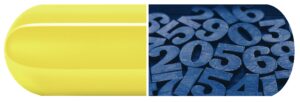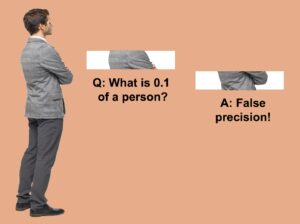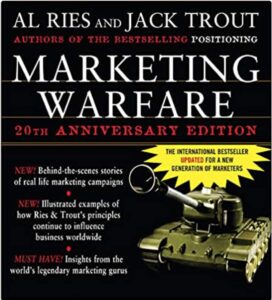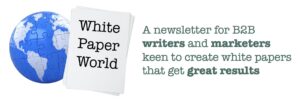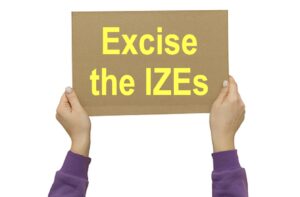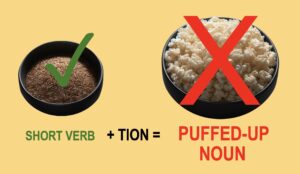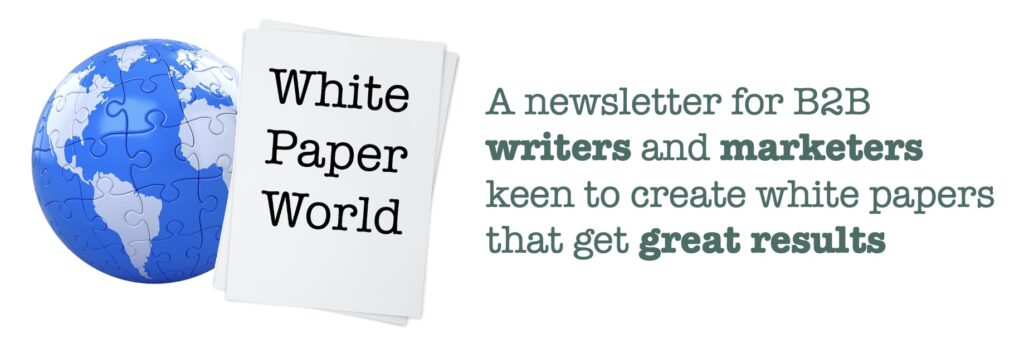
White Paper World 38: March 22, 2024
- Quick tip: Here’s how to handle LSD
- Fresh content: White papers and… the Greek gods?!
- March book winner: Erica Vega
- Marketing Warfare and fabulous flanking
- Remembering John Gallop
Click here to listen to this entire issue, 16:15 minutes
Quick tip: Here’s how to handle LSD
3 minute read. 3:15 minute listen.
No, this isn’t advice on avoiding bad trips.
This is about writing numbers crisply and clearly.
And to do that, you need to know how to handle the Least Significant Digit (LSD).
One of my pet peeves is false precision: a number that suggests more accuracy than it can possibly convey.
For example, suppose a company reports on a survey of 3,000 people like this:
And 53.17% of respondents agree you can’t trust anything you find online.
But 53.17% of 3,000 people = 1,595.1 people.
That can’t be. What is 0.1 of a person? They’ve botched the LSD and stated an impossibly over-precise figure.
Which number should you use?
To avoid false precision, drop anything past the least significant digit.
In other words, use the fewest possible digits to convey a number as precisely as you need.
So a better way to report that number is to say:
And 53% of respondents agree you can’t trust anything you find online.
Even better, use both words and numbers:
More than half the respondents (53%) agree you can’t trust anything you find online.
How do you know which digits are significant?
It’s all about the context.
For instance, say you drive to a meeting.
If someone asks how far you drove, you probably say “about 40 miles.”
In casual conversation, you round a trip to the closest 10 miles. The LSD is the “4” in “40.”
But when you fill in your expense report, you write “43 miles.” To get all the credit you can, you use more precision. So the LSD becomes the “3” in “43.”
Meanwhile, your trip odometer says you drove 43.27 miles.
Few people care about 0.27 of a mile. But in a measuring instrument like an odometer, we expect maximum precision.
How to blend numbers and narrative
When reporting numbers in a white paper, blend them into the narrative so your reader doesn’t have to stop to think about them.
I often give an approximation in words and then show the number after, like this:
- almost 3 out of 4 (73%)
- more than 4 out of 5 (86%)
White paper readers are busy people. They’ve taken precious time to read your work.
It’s worth spending a bit of your time making sure your numbers are crisp, clear, and easy to handle!
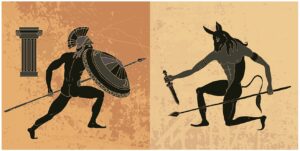
Theseus and the Minotaur shown in the style of ancient Greek pottery
Fresh content: White papers and… the Greek gods?!
Full article 3.5 minute read. 6 minute listen.
In ancient Greece, tales of the gods served to inspire, caution, and educate mortals.
Today these legends can guide us to create white papers that ascend to the heights of Mount Olympus.
From the wise strategy of Athena to the red thread of Theseus…
from the musical harmony of Apollo to the speedy delivery of Hermes…
these timeless myths can still inspire white paper writers today.
Read my full article on white papers and the Greek gods.
Or click here to listen:
March book winner: Erica Vega
3.5 minute read. 3 minute listen.
Last month I asked subscribers to send in shoddy statistics. Among the readers I heard from is Erica Vega, this month’s book winner.

Erica Vega, versatile copywriter
I met Erica when she signed up for a white paper program I taught through AWAI.
She caught my attention with her quick grasp of the material and all-around lively and accomplished writing style.
Since then, Erica has been on an eventful journey.
After building a thriving freelance business near Chicago, Erica had to deal with the loss of two family members: her stillborn daughter and her mother.
“Grief takes so much work,” she says. “And I just didn’t have the energy to work one-on-one with so many people.”
So she stepped back from dealing with clients to become a full-time copywriter for a property and casualty insurance company based in Illinois.
Today Erica writes both B2B for insurance agents and B2C for customers. Working remotely, she appreciates her company’s enlightened management.
“I really could not have asked for a better situation,” she says. She enjoys the stability of full-time work plus the variety of many different projects.
She writes blogs, e-mails, newsletters, scripts, templates, web pages, and anything else that comes up.

And while she’s happy with her job, Erica isn’t one to sit still.
As a side project, she’s starting a money-making website to help people like tarot card readers and Reiki teachers build their businesses.
She’s been drawn to this world all her life. And she recently began to listen more carefully to the unique language of its practitioners.
“I haven’t seen a leader in this space in terms of teaching people how to market, advertise, and run a business,” she says. “So that’s what I intend to do.”
As a bridge between the mystical and the practical, Erica will help people in this under-served niche build more viable and sustainable businesses.
Good luck, Erica!
Erica’s shoddy statistic
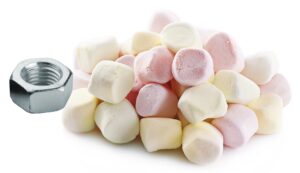
Erica suggested the old chestnut:
“Muscle weighs more than fat.”
“I’ve heard that from doctors and fitness coaches. And I used to repeat that myself,” she admits.
But when Erica said it to her coach at the gym, he quickly corrected her.
“Muscle doesn’t weigh more than fat,” he said. “Five pounds is five pounds.”
The confusion comes from the fact that muscle is more dense than fat.
Just as a pound of steel is small and hard, a pound of marshmallows is big and fluffy.
But a pound is still a pound, no matter how much volume you need to get to that weight.
Thanks, Erica, I hope we all remember that.
Marketing Warfare and fabulous flanking
2 minute read. 2 minute listen.
For her book prize, Erica Vega picked Marketing Warfare by Al Ries and Jack Trout, one of my personal favorites.
This book taught me the four types of marketing campaigns: offensive, defensive, guerrilla, and flanking.
White papers can be used for any type, but my favorite is a flanking campaign.
Here’s how it works:
Often one firm is the dominant player in a certain space, the acknowledged king of the hill with their own castle.
You could attack them directly.
But that’s an offensive campaign, fighting your way up a mountain against a fortified position. Hard to do and you have no guarantee of success.
It’s much easier to use a flanking campaign.
That’s where you turn your back on the incumbent, find a nearby mountain, and declare yourself king of that hill.
This works really well in tech, where you can create a new category with a cool acronym that suggests the latest and greatest.
Then you can steal customers away from the incumbent by calling them over to your mountain.

It’s hard to fight your way up a mountain
Now, if that company wants to fight, they have to claw their way up your mountain.
And you get to wage a defensive campaign, which is probably the easiest of all.
I’ve done white papers to help software companies outflank their competitors and it’s always a thrill.
You can tell it’s working when a much bigger, more established company starts taking potshots at your new acronym.
Sometimes they even publish their own white papers to criticize yours. And the battle is on!
Remembering John Gallop
1 minute read. 1:45 minute listen.
We fell silent for a month as our family grieved the death of my father-in-law.

John Gallop canoeing
John was a kind and gentle Dad to my wife and partner Angie.
He was also a wise “Grandpa Gallop” to our children and a faithful husband of 56 years to his wife Kathy.
A lifelong hunter and fisherman, John was probably never happier than when he was out on the water.
This photo shows him on a day when the bush town of Searchmont flooded. As the principal of the town’s school, he paddled along the flooded highway to check on the building.
On the way, when he saw any students out in their yards, he yelled, “C’mon! We’re going to school!” as though his canoe was replacing the school bus.
A Canadian through and through, John played hockey well into his 70s and watched games on TV until the end.
He was always a great storyteller. In his final year, he wrote a 73-page memoir that I had the pleasure to read before I wrote his eulogy. You can see that here.
John was known to everyone who met him as a gentleman with a kind heart, a quick smile, and an amusing story to share.
We miss you, John. We always will. Rest in peace.
That’s all for this issue

Gordon Graham, That White Paper Guy
I hope you find this newsletter interesting and useful.
Please pass this along to anyone you think would appreciate it.
You can see all the previous issues here: www.thatwhitepaperguy.com/newsletters/
And to see every future issue, subscribe here:
www.thatwhitepaperguy.com/subscribe/

Gordon Graham
That White Paper Guy

